Problem 1: Chickens need to get plenty of fresh air and exercise. They need soft dirt to scratch in. They do best on a varied diet that includes greens and bugs. In the summer they need shade and some cool earth to lie in. Much of the day my chickens are confined to a packed-dirt pen. It’s not optimum.
Problem 2: Every day, I fill a bucket on my kitchen counter with the scraps from my kitchen endeavors. There are onion peels, over-toasted waffles and carrot scrapings, coffee grinds and desiccated oranges. I’d like the hens to get the good stuff, but even chickens won’t eat all of it. How to feed the chickens the worthwhile bits and compost the rest without sorting through these dregs? I have other stuff to compost, too, including weeds and damaged vegetables from the garden, and the muck and trampled on hay from the goat stall. There’s a lot of material from different sources, but I don’t want to fuss with it. I want one easy pile.
Two problems, one solution: build a compost bin in the chicken run. The hens will eat what they like, and shred everything else into little bits. In the summer it becomes a cool, damp respite from the heat. In the winter it’s the one spot that’s not frozen that they can dig in. At all times there are yummy morsels to eat and bugs to unearth. It’s barely any effort for me – the chickens do all of the work of mincing the material and turning it over. Soon enough, it decomposes, shrinks in size, and it turns into good garden soil.
I’ve sited a compost area to the side of the little barn. I’ve put a sturdy piece of fencing blocking it off, but have left openings on both sides. The two exits ensure that the hens don’t get trapped in a corner or bullied.
If you don’t see the chickens on the HenCam, this is where they are.
The rest of the chicken yard I keep raked and tidy. As I mentioned in a previous post, I compost the chicken manure elsewhere. I move that away from where the hens live, so that I break any potential parasitic lifecycle.
Early in the springtime, the compost gets forked out. Later in the summer, when it fills up again, I’ll shovel it out once more.
The bottom is dark brown, rich earth. The top isn’t fully decomposed, but that goes, too. There’s a big patch in the meadow where nothing grows because the soil is so thin and poor. The compost is dumped there. While doing this chore, the chickens are allowed out, and they help to spread it.
Four years ago I created a pumpkin patch in the meadow with with compost from the chicken run. Look at how beautiful the soil there is now! The hens are busy eating up overwintering garden pests. Good work, girls!
You can see all of this in person. There’s still a few remaining slots in the Chicken Keeping Workshops. Come either March 31 or April 14.
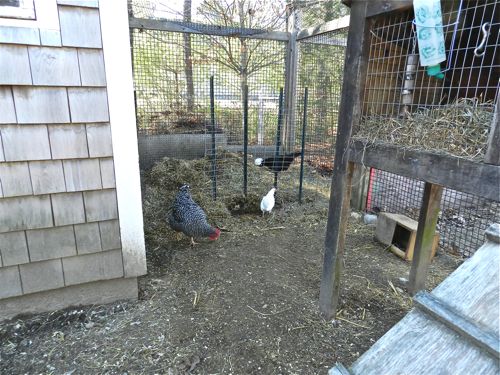
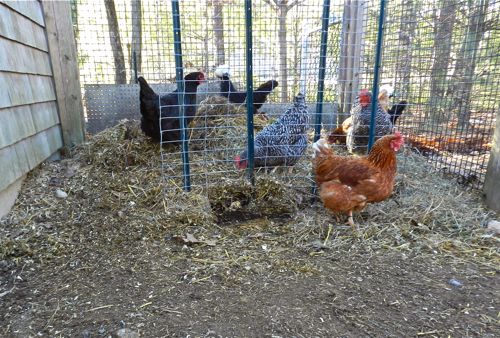
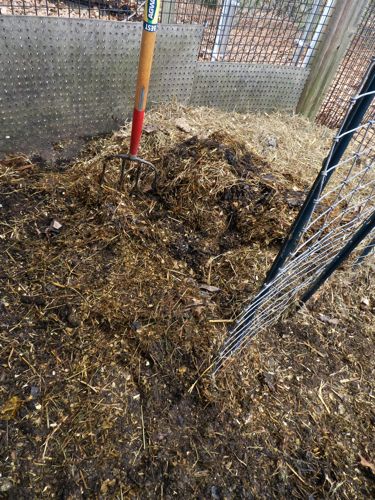
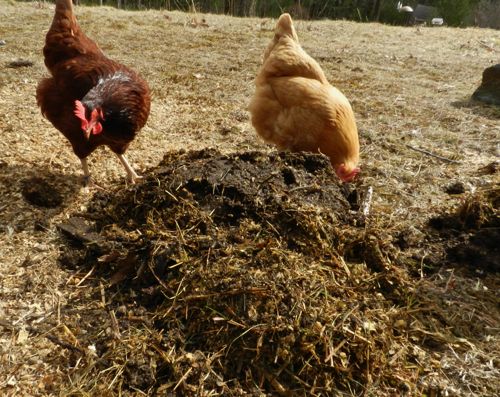
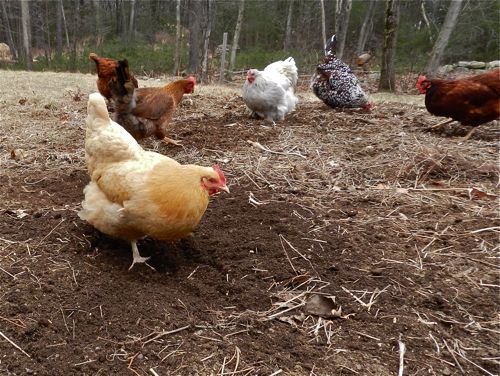
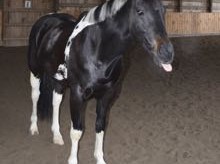
Very useful information. We have plans to tear down our old coop and build a new one….this will for sure be part of it. Hope you are doing good, Terry!
Terry! Is it really 56 degrees there today? Wow! I think you might be warmer than us in So. Ca.!
going up to 70!
When Pip and Caper’s camera is showing their paddock,you can sometimes see one or two white heads bobbing I’ve the compost area.
I like your idea, plan on doing that myself, thanks!
I love reading about all your ideas, Terry -and I don’t even have chickens!!
Ditto
This is great information for me! I have a compost bin set up for our chicken and rabbit waste and plan on putting all our yard and kitchen waste in part of their run. Would you mind sharing what you don’t compost there? I’m wondering about spent tomato and potato plants (I think they might be poisonous), raw potato peels, and other things the chickens might be sensitive to. I’ve read that you shouldn’t give the chickens onion peel because it will make the eggs taste onion-y. Have you ever found that to be a problem?
Few plants are toxic, and then only if they are the sole source of food (Buffy once got very sick from too much vetch.) Potatoes (even the green bits) and eggplant are fine! I put the onion skins in the compost. Then hens don’t like them, so they just decompose. I’ve never had a flavor problem with them. Coffee grounds are fine. Mushy, yucky old stuff found hidden at the back of your vegetable drawer are fine. The hens don’t eat it, but it does get shred and turned into lovely dirt. The one thing that is poisonous, specifically to chickens, is avocado. Never give them access to any part of the avocado. Do keep in mind that the bulk of their food should come from their laying hen pellets. The compost certainly isn’t a balanced ration. But it is fun for them and very helpful for us.
Thank you Terry about the info on avocado! I didn’t know about that! Recently had some avocado left overs, and frantically trying to remember if I did give to the girls with the other salad left overs – Pretty sure I pulled them out.
I may not have room in my chicken pen for compost, but for the last three weeks have been spading up much of it, the girls love it, they now get all excited when they see the shovel because they know whats coming. They get lots of juicy earth worms – one Bard Rock is always right there where the spade is going in, and is usually the first to get the worms. Fun to watch.
Thanks, Terry! Your post really struck me because I recently about something similar in “The Small Scale Poultry Flock”. The author recommends throwing garden waste, etc. into static chicken runs as almost a kind of mulch. That way the chickens get entertainment, their waste is absorbed rather than flowing away and possibly polluting groundwater, and you get compost at the end. How can you go wrong? I set up a separate bin for my chicken coop and rabbit waste and plan on chucking everything else in the run. (Check out http://theharriedhomemakerpreps.blogspot.com/2011/10/it-is-finished-almost-chicken-moat-and.html if you want to see our set up.)
I’m not fond of the composting systems that take up the entire pen (a version of deep litter.) Unless you have the right proportion of chickens to area to material to moisture, it can get both stinky and unhealthy. (I’ve seen this happen.) Also. the material builds up and you’ll have problems at the doors and with it spilling out of the wire fencing. But, contained in one portion of the run, you don’t have those issues and you get all of the benefits. One other consideration for me is that my barns are in my backyard and part of my landscaping plan. It has to be practical, but decisions are also made with an eye for beauty!
I made a hardware cloth hoop abbot 4 feet in diameter with a nice wide opening that is bent off so as not to poke anyone. I held it up with the kind of posts from my electric fence. It is inside my coop. I put grass clippings in it (no chemicals on my lawn) and leaves and some but not all of my kitchen waste. The hens love it. They turn it constantly but it mostly stays inside the hoop. The only thing that gets stinky is old wet lay crumble, which I now compost Iin a similar bin outside the coop, along with poop and stuff I don’t want them to eat. Extra grass clippings fixed the stink. I then planted a chayote squash vine next to the inside bin and fenced them out ’till it was out of their reach. Now they have shade and leaves to eat and it feeds off the compost and is very productive. I harvest leaves for stir fries and squash for my mom. I originally got this idea to put the compost in my hen yard from you Terry. Thank you – it works great!
I am SO pleased that this works for you! How clever to plant chayote. I bet it grows like a jungle weed in Hawaii.
It does! I whack it back twice a year or it would consume my house as well as the coop!
I followed your lead, and started piling compost in the back of the run. It’s worked beautifully! Also followed your suggestion of putting sand in the muddy areas of coop and run. It has made ALL the difference.
So pleased it works for you, Lauren!